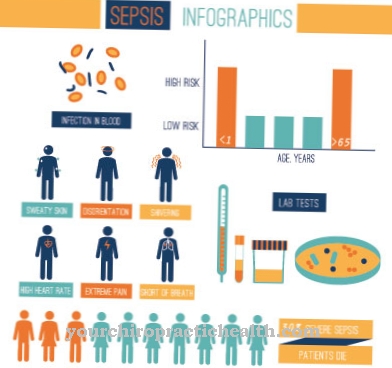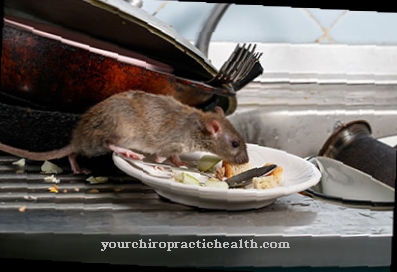The necrotizing enterocolitis is a disease of the intestine that occurs primarily in premature babies. The exact causes have not yet been clearly clarified. Even if the treatment of the disease is becoming more and more successful, it still occurs frequently and in not a few cases leads to death.
What is necrotizing enterocolitis?

© photostriker– stock.adobe.com
Under one necrotizing enterocolitis Doctors understand a serious bowel disease that occurs primarily in premature infants.
This is an infection associated with impaired blood flow to the intestinal wall. The tissue becomes necrotic and changes. Putrefaction gases accumulate and, in the worst case, the contents of the intestine penetrate the abdominal cavity. The affected newborns have a distended stomach, can no longer tolerate food and may vomit bloody bile.
Statistics show that every 10th premature baby is still affected by necrotizing enterocolitis. Although medicine is advancing, the mortality rate in premature babies is still 5-10%, depending on the birth weight and general condition of the infant and the stage at which the disease is recognized.
causes
The exact causes of the emergence of the necrotizing enterocolitis are not yet clarified. Doctors were able to identify numerous risk factors or circumstances that seem to favor the disease.
However, it could not be determined whether some factors have a greater influence on the development of the disease or not. Possible triggers of necrotizing enterocolitis include previous illnesses such as certain heart defects (for example coarctation of the aorta, narrowing of the aorta).
But also conditions such as a volume deficiency shock, in which there is a decrease in the amount of blood in the vessels due to a strong loss of fluid, or a respiratory distress syndrome, a lung dysfunction in newborns, are said to promote the development of necrotizing enterocolitis. This also applies to hypoglycaemia, hypothermia, low blood pressure or the insertion of a catheter through the umbilical cord vessels.
Symptoms, ailments & signs
The disease usually begins insidiously. Your progression is classified according to different stages. In stage I, the first signs appear in the form of unstable body temperature, a bloated stomach that is sensitive to touch and the refusal to eat. In addition, respiratory arrests occur again and again. The child looks pale, their complexion turns gray, and they are sleepy.
There may be bloody stools. In stage II, the general condition worsens even more. The child hardly reacts to pain stimuli and the body cools down, especially arms and legs feel cold. The pauses in breathing increase and the heartbeat slows down. You vomit bilious gastric juice and the amount of blood in the stool increases.
If the child stops responding, they must be ventilated. This condition can quickly worsen and progress to stage III. The intestinal tissue dies, causing its contents to flow into the abdominal cavity and cause life-threatening peritonitis. There is a risk of sepsis. The stomach is then very tense, reddish spots form on the flanks and water retention occurs. In most cases, these stages occur one after the other. However, it can also happen that the disease worsens dramatically from stage I to stage III within a few hours.
Diagnosis & course
A necrotizing enterocolitis can still be diagnosed in the clinic by the attending physicians.
First, a general physical exam of the premature baby is done, along with a comprehensive blood test. In addition, imaging procedures provide information about clear symptoms such as thickened intestinal walls and enlarged intestinal loops. Often gas bubbles can also be seen. If the intestinal wall is already perforated, leaked air can also be detected in the abdominal cavity.
An ultrasound can similarly provide clear evidence of necrotizing enterocolitis. If necrotizing enterocolitis remains untreated or if it is recognized too late, the perforations in the intestinal wall just described will occur. This allows intestinal contents to enter the abdominal cavity, which leads to sepsis and can be fatal.
Complications
In the worst case, this disease can lead to death. Parents and relatives in particular can react to this with psychological upset and sometimes need psychological treatment. As a rule, those affected with this disease suffer from various complaints in the region of the stomach and intestines. This leads to bloody stool and vomiting more often.
A bloated stomach and insufficient bowel movements can also occur and further reduce the patient's quality of life. In many cases, patients with this disease also have very pale skin color and circulatory problems. It can also lead to peritonitis without treatment, which in the worst case can be fatal.
Usually this disease can be treated with the help of antibiotics. There are no complications. However, those affected are still dependent on surgical interventions or on the removal of the bowel and thus receive an artificial anus. This leads to considerable restrictions in the patient's everyday life. If the treatment is successful, the life expectancy of the person affected is usually not reduced.
When should you go to the doctor?
If premature babies show persistent or increasing abnormalities in behavior, there is usually cause for concern. Apathy, indifference or a strong restlessness indicate health impairments that should be examined. A doctor is needed in the event of refusal to eat or drink, severe tearfulness, or insomnia. Special features of the skin, discoloration or a dull skin structure must be presented to a doctor. A doctor should be consulted in the event of sensory disorders, hypersensitivity to touch or an increased body temperature. If there is severe flatulence, blood in the stool or urine, or swelling, the symptoms must be clarified.
Vomiting, interruptions in breathing and disorders of the heart rhythm must be referred to a doctor immediately. If water retention is noticed, the child is not responding adequately to social interactions or circulatory disorders occur, medical attention is needed. A doctor should be consulted if the limbs are cold, if there is a slight reflex reaction or if spots form. As the disease can end with the premature death of the patient if left untreated, a doctor should be consulted as soon as possible. If existing complaints increase in scope and intensity within a few hours, action is required. In the event of an acute condition, an ambulance service must be alerted. At the same time, adequate first aid measures must be initiated to ensure the infant's survival.
Treatment & Therapy
Clearly became one necrotizing enterocolitis When diagnosed, the gastrointestinal tract diet must first be adjusted. Meanwhile, the premature baby is given all the necessary nutrients via infusions.
Usually this measure has to take place over a period of up to ten days. The disease itself is treated with antibiotics. The blood flow to the intestinal wall can also be supported or improved with medication. If the intestinal wall has already been perforated, the affected parts of the intestine must be surgically removed. The earlier this intervention takes place, the smaller the section to be removed.
An artificial anus has to be placed temporarily, which can be slowly replaced by normal bowel activity after about eight to ten days. If the disease is recognized early enough and treated appropriately, the prognosis for neonates with necrotizing enterocolitis is quite favorable.
Outlook & forecast
The prognosis of the disease depends on how quickly the clinical picture of necrotizing enterocolitis and the resulting sepsis could be recognized. It also plays a major role how timely an adequate treatment was started. The chances of recovery of those affected always depend on the severity of the disease. If an occurring sepsis can be well controlled with the right medication, the patient's prognosis is not bad. Treated only around 5 to 10 percent of the affected newborns die.
If the disease is untreated, around 10 to 30 percent die. If the necrosis has expanded to larger sections of the intestine, the child will quickly develop short bowel syndrome. The bowel must be removed when it is no longer recovering. The more intense the patient's symptoms and the more advanced the disease, the more often an operation will be necessary. However, there is always the risk that the removal of some sections of the intestine will cause so-called short bowel syndrome in the patient, which can lead to malnutrition and diarrhea. On average, around ten percent of those affected suffer from short bowel syndrome. About ten percent of patients also suffer so-called strictures of the intestine as the disease progresses. These then urgently require a new surgical intervention on the patient.
prevention
A preventing one necrotizing enterocolitis is not yet possible. Scientists try, among other things, to protect premature babies from the disease by giving them antibodies or prophylactic antibiotics. However, a proven preventive effect is not yet known.
Careful observation of the premature baby in the clinic is therefore the best and only way to recognize possible symptoms in good time and to initiate therapy. This can prevent the disease from progressing and potentially fatal.
Aftercare
Follow-up care for necrotizing enterocolitis is only possible to a very limited extent. It depends on the type of treatment. With drug treatment, rehabilitation is less conflictual than after surgery. The age of the child and the length of stay in the neonatal intensive care unit also have an influence.
Follow-up care is initially carried out completely as an inpatient. The child stays in the hospital until they can eat again and gain weight steadily. In some cases, infusions are used for this. Regular follow-up examinations are required after discharge from the hospital. These initially take place at relatively short intervals. In the event of a positive development, this is done monthly, later annually.
Rest and protection of the body are important for aftercare in your own home. Avoid physical exertion. It can also be observed whether there is vomiting, constipation, absent bowel movements or anemia. In these cases a doctor should be consulted. In some cases, further antibiotic use is necessary as follow-up care. It is important to ensure that it is taken correctly. Necrotizing enterocolitis is a serious complication and can lead to long-term health problems.
You can do that yourself
Necrotizing enterocolitis is a threatening clinical picture and therefore needs intensive medical treatment. Parents of the newborn therefore quickly feel banished into the role of spectators and left alone with their fears. It is important for both partners to request emotional support at an early stage and to accept the help offered. Fears should be openly discussed with everyone involved. Any siblings should not be left out either.
The sick newborn should be allowed to come into contact with the parents as often as possible and, if possible, they should also take over care activities themselves. The professional care team will usually be happy to respond to this request.
If, in the course of treatment, a section of the intestine is removed and an artificial anus is created, the clinics usually offer appropriately trained staff to care for it. Usually this so-called “anus praeter” is only a short-term solution. If there is a threat of short bowel syndrome, the child's further nutrition and individual needs should first and foremost be discussed with the attending physician. If necessary, an experienced nutrition therapist will provide further advice. In this case, it is difficult to make general recommendations and the individuality of each patient must be given special consideration.






.jpg)

















.jpg)



